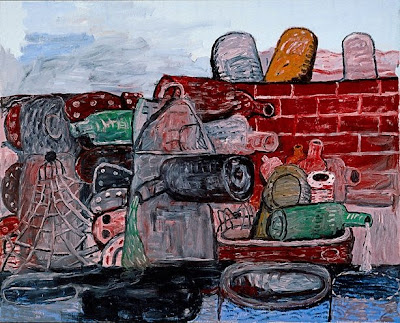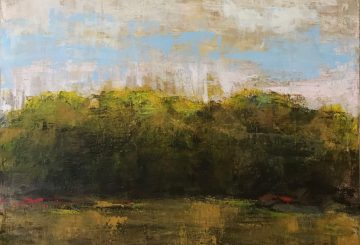Too much history? Not enough? Rory Dufficy contemplates the inclusion – and exclusion – of particular historical works in this year’s Biennale of Sydney...
The much criticized decision by Biennale curator Carolyn Christov-Bakargiev to include works from the backrooms of various Australian galleries – an inconsequential Malevich drawing, a spectacularly useless sketch of Spiral Jetty by Robert Smithson – was not, I think, a bad one. What it enabled was for her to construct a very particular narrative, with a very particular endpoint, and with a very particular conception of “revolution” (a highly suspicious concept, used aesthetically, and my every use of the word should be assumed to contain these qualifying inverted commas).

Philip Guston, East Tenth, 1977.
Oil on canvas, 203x255cms.
Collection: Art Gallery of New South Wales
It is perhaps unsurprising that a curator based in Turin would lean so heavily on a Eurocentric conception of revolution, and, in particular, on the primary post-war revolution from Italy, arte povera. What is noticeably absent is a focus on post-war revolutions in the anglophone world – in particular, of course, the United States. While it could be argued that the stories and counter stories of AbEx, Colour Field, Pop, Minimalism etc have been heard many times and constitute a sort a hegemonic discourse about post-war avant-guarde art – there is much to be said for the deconstruction of Greenbergian progress – Christov-Bakargiev is not a curator afraid of the obvious, as evidenced by her inclusion of Duchamp’s Bicycle Wheel readymade, and clearly believes in outlining a sort of history of 20th century aesthetic revolutions, which is, in part, helpfully done for her by Lia Perjovschi’s work, Mind Map (Diagram).
There is nothing wrong with a curator outlining her own vision of the course of post-war art, and understandable that many American artists will be underrepresented due to the unavailability of works. What seems clear, though, is that Christov-Bakargiev’s aversion to painting stretches further back than her lack of interest in contemporary painting. The argument for largely excluding contemporary painting from Biennales seems solid, in that painting, being the most marketable form of art, finds a natural home in commercial galleries (although this argument is less solid for international artists that one might wish to see more of, like, say, Neo Rauch). What seems strange is that Christov-Bakargiev has chosen to ignore post-war painting almost entirely. An obvious example that might have been included is Cy Twombly’s Three studies from the Temeraire, which normally hangs in the Art Gallery of NSW foyer but which had to moved to make way for Nedko Solakov’s A Life (Black and White) .
More conspicuous, at least to me, was the exclusion of anything by Philip Guston, of whose work the AGNSW has a number of fine examples. While any Biennale viewer could ride the escalators down to the twentieth century galleries and see this work, it would seem to speak to Christov-Bakargiev’s general lack of interest in painting that Guston’s work – a true revolution from figuration to abstraction and back to figuration – was not included in her historical survey, especially as she’s willing to include such meaningless work from artists like Smithson. Guston’s work is also revolutionary in a more metaphorical sense: the junkman’s son retreats into himself and, in feat of properly mythological self-examination, decides to paint like, in Hilton Kramer’s famous words, a ‘stumblebum’; he confronts entrenched establishment abstraction with a coarse drunken line and a direct taking-stock of contemporary politics, something which was verboten among the flat mandarins of the New York School. That he did all this and had perfectly appropriate left-wing politics (something which is, admittedly, not particularly conspicuous in the AGNSW’s holdings) should have ensured him a place.
Indeed, his exclusion says something interesting about the position of painting in contemporary art, particularly figurative painting, and the difficulty that some curators and critics, educated in the high conceptualism, have in evaluating the position of high-quality contemporary painting, even if, as in Guston’s work, there are plenty of obvious jumping-off points for windy critical exegeses. But Guston’s work does more than just pose politically, it does what all good painting does, which is be itself. As interesting psychologically (and, of course, aesthetically) as his Ku Kux Klan and Nixon paintings are, Guston’s late work reveals itself most in the absolute thinghood of his beer bottles, his leather shoes, his bulbous bowls of cherries and his cartoon cigarettes. Guston carefully caresses the detritus of modernity, and is not afraid of nostalgia, just as he is not afraid of grandiloquence and not afraid of bathos. His fearlessness means that even when his work leans in these directions it retains an authoritative honesty – every object seems to jump out of the canvas and declare its being.
Proust, in an interview of 1913, called style “a quality of vision, the revelation of the particular universe that each of us sees and that no one else sees. The pleasure an artist offers us is to convey another universe to us”. Guston certainly did this and in that respect maybe he’s not so revolutionary after all.

